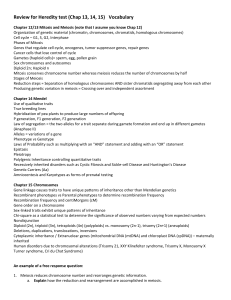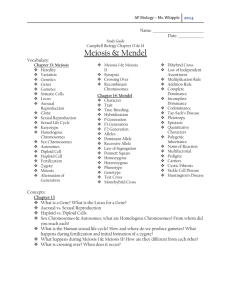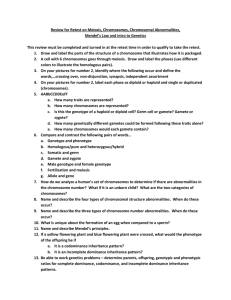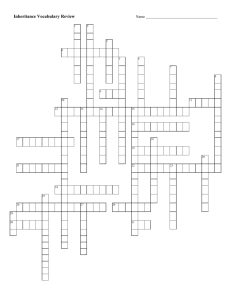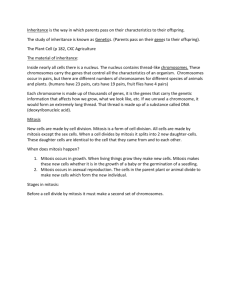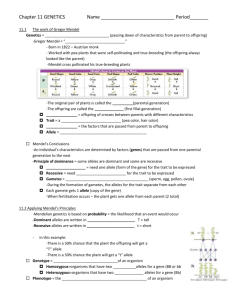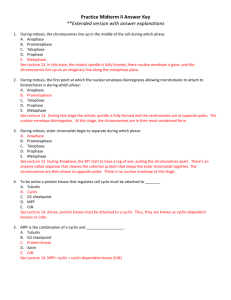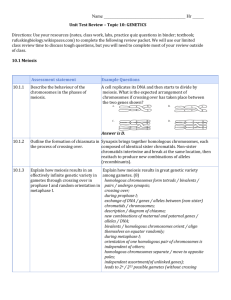Study Guide
advertisement
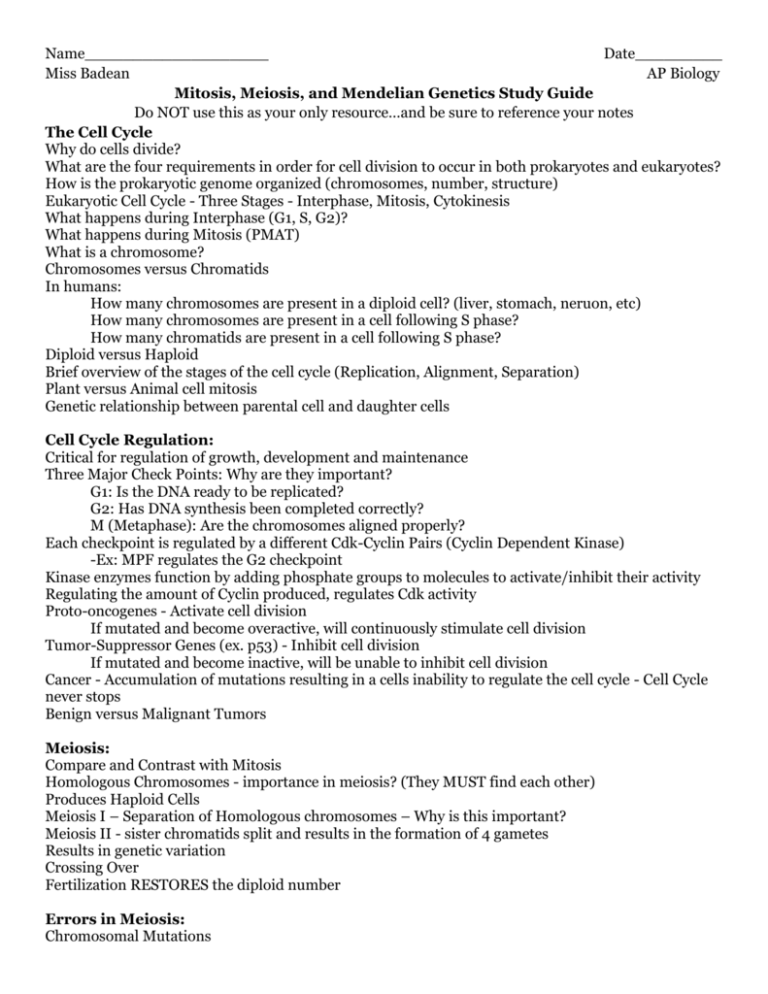
Name___________________ Date_________ Miss Badean AP Biology Mitosis, Meiosis, and Mendelian Genetics Study Guide Do NOT use this as your only resource…and be sure to reference your notes The Cell Cycle Why do cells divide? What are the four requirements in order for cell division to occur in both prokaryotes and eukaryotes? How is the prokaryotic genome organized (chromosomes, number, structure) Eukaryotic Cell Cycle - Three Stages - Interphase, Mitosis, Cytokinesis What happens during Interphase (G1, S, G2)? What happens during Mitosis (PMAT) What is a chromosome? Chromosomes versus Chromatids In humans: How many chromosomes are present in a diploid cell? (liver, stomach, neruon, etc) How many chromosomes are present in a cell following S phase? How many chromatids are present in a cell following S phase? Diploid versus Haploid Brief overview of the stages of the cell cycle (Replication, Alignment, Separation) Plant versus Animal cell mitosis Genetic relationship between parental cell and daughter cells Cell Cycle Regulation: Critical for regulation of growth, development and maintenance Three Major Check Points: Why are they important? G1: Is the DNA ready to be replicated? G2: Has DNA synthesis been completed correctly? M (Metaphase): Are the chromosomes aligned properly? Each checkpoint is regulated by a different Cdk-Cyclin Pairs (Cyclin Dependent Kinase) -Ex: MPF regulates the G2 checkpoint Kinase enzymes function by adding phosphate groups to molecules to activate/inhibit their activity Regulating the amount of Cyclin produced, regulates Cdk activity Proto-oncogenes - Activate cell division If mutated and become overactive, will continuously stimulate cell division Tumor-Suppressor Genes (ex. p53) - Inhibit cell division If mutated and become inactive, will be unable to inhibit cell division Cancer - Accumulation of mutations resulting in a cells inability to regulate the cell cycle - Cell Cycle never stops Benign versus Malignant Tumors Meiosis: Compare and Contrast with Mitosis Homologous Chromosomes - importance in meiosis? (They MUST find each other) Produces Haploid Cells Meiosis I – Separation of Homologous chromosomes – Why is this important? Meiosis II - sister chromatids split and results in the formation of 4 gametes Results in genetic variation Crossing Over Fertilization RESTORES the diploid number Errors in Meiosis: Chromosomal Mutations Disjunction versus Nondisjunction Nondisjunction can occur in both meiosis I or II Nondisjunction events involving sex chromosomes do not usually result in spontaneous abortion Most autosomal chromosomal mutations result in spontaneous abortion Amniocentesis and Karyotyping Genetic Testing - Ethics Changes in Chromosomes Inversion Duplication Translocation Insertion or Deletion Mendelian Genetics Study Guide Gregor Mendel and his experiments with pea plants P, F1, and F2 generations Dominance versus Recessive – Law of Dominance – Which genotype tells you dominance? Genotype versus Phenotype Test Cross - purpose? how do you perform them? Alleles - How many alleles do you inherit for a particular gene? Law of Segregation Law of Independent Assortment How many genetically distinct gametes can an individual with the genotype AaBBCcDDEe produce? 2n , where n = number of traits the individual is heterozygous for Rules of probability can be applied to analyze the passing of genes from parent to offspring – If a parent has the genotype AaBBCcDd and the other parent has the genotype AABbCcDD, what is the probability of them producing a child that has the genotype AaBBCCDd? Segregation and Independent Assortment can be applied to genes that are UNLINKED (located on separate chromosomes) Patterns of Inheritance: monohybrid, dihybrid, sex-linked, incomplete dominance, codominance, genes linked on the same homologous chromosome) can be predicted from data that gives the parental OR offspring phenotypes/genotypes Blood Types = Multiple Alleles can exist (more than 2) for a particular gene Chi-Square Analysis of data Many patterns of inheritance do NOT follow Mendel’s Laws (linked genes, incomplete dominance, codominance, multiple alleles, Sex-linked traits) Pedigree Charts – know how to read them and figure out the pattern of inheritance it displays Linked genes versus Unlinked Genes Recombination Frequency Gene Mapping using recombination frequencies 1% = 1 map unit Environment can influence gene expression Chloroplasts and Mitochondria carry their own DNA that codes for other traits (non-nuclear inheritance) Chi-Square Analysis: -Null hypothesis -Use of the formula -Degrees of freedom -P value (p= 0.05 versus p = 0.01) -Critical Value Table – How to interpret **Formula and Table will be provided to you for the exam!**



